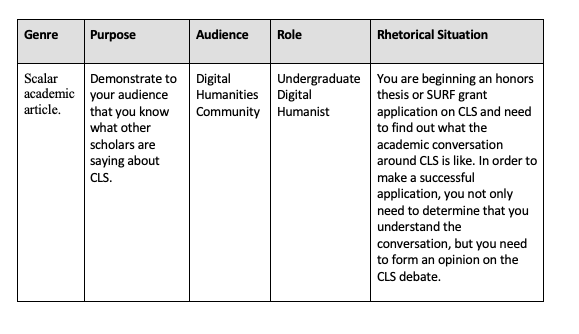Unit 1 Project
Scalar Research Paper
The main focus of an academic research paper is to develop a new argument, and a research paper is likely to contain a literature review as one of its parts. In a research paper, you use the literature as a foundation and as support for a new insight that you contribute.
The Scalar page should be between 1200-1500 words.
Rhetorical Chart
Scalar Website:http://scalar.usc.edu/works/the-computational-literary-studies-debate/index
Last spring, a premier journal in the humanities, Critical Inquiry published a now infamous article by Nan Z. Da called “The Computational Case Against Computational Literary Studies” and a series of reactions both for and against the use of algorithms in the analysis of literary objects. Computational Literary Studies (CLS) raises hope for the potential of new methodologies and understandings of literature. Whether CLS will create “bad literary criticism” or “lacks quantitative rigor,” it is clear that opposing sides have very different assessments of the implications of using computation in literary studies. While each writer challenges the foundations, definitions, and positions of the other, in some ways, they seem to be talking to one another in a manner that lacks the sincerity of an intellectual debate.
As a new student of Digital Humanities (and budding writer), you are now confronted with two problems.
- Beyond what I have learned from Da and others, how do I develop my own critical understanding of the CLS debate?
- As a critical reader of Da and others, how might I further, challenge, remedy, question, or interrogate their core claims and methods of argumentation?
In consideration of these problems, you are now asked to compose an evidence-based, multi-media argument in Scalar that helps your reader to:
- Understand, beyond a pro/con debate, the complex issues, potential dangers and potential benefits of CLS.
- Understand at least one aspect of struggle in the academic conversation between Da and another scholar. As an example, where are these two writers failing to connect with each other? Where is communication breaking down in this exchange exactly, and how? You can take a side to the debate or instead of taking a side in the debate, you can explore the problem, enter into the conversation, and comment about (and perhaps resolve) the debate.
Here is the Rubric used to grade the assignment.
